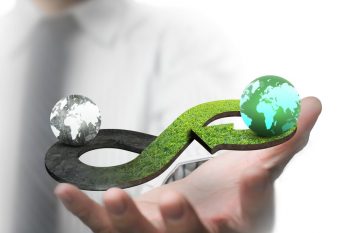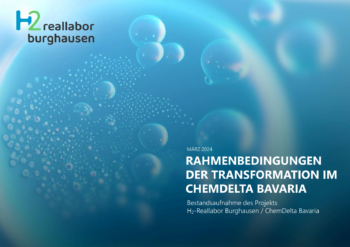Series of articles concerning hydrogen: Raw material demand for hydrogen prodution
In the course of the last few years, an immense dynamic can be felt in the field of hydrogen. At the same time, great progress has been made in research and development at many points along the hydrogen value chain and important findings have been made. In the first series of articles on hydrogen, the basics of the gas were explained along its value chain from production to transport and storage to application. In this second series, individual focus topics are dealt with in detail and the current state of knowledge is summarized. This second article deals with the raw material demand for hydrogen production.
Overview of the topics in the hydrogen series
- Use of hydrogen in steel production
- Raw material demand for hydrogen production
- Life cycle assessment of hydrogen
- Electrolyzer operating modes
- Efficiency of hydrogen transport
- Roadmaps for developing a hydrogen infrastructure
As already shown in our article “Wo soll Wasserstoff verwendet werden?” in the first series, green hydrogen and synthetic energy carriers based on it play a central role in the defossilisation of our energy and economic system. The resulting significant future demand will be largely met by the electrolysis of water with electricity from renewable sources. This will require extremely ambitious annual rates of electrolyser installations in the coming years and decades, both in Germany and globally. However, since potentially critical raw materials are used in electrolysers, depending on the technology, it is important to investigate whether a lack of availability of these raw materials could limit and slow down the necessary expansion of global electrolyser capacities. In addition to pure availability, the criticality of raw materials has other dimensions that will not be covered in this article.
In this article the raw materials Nickel, Platinum and Iridium will be investigated being relevant in Alkaline Electrolysis (AEL), Polymer Exchange Membrane Electrolysis (PEMEL), and Solid Oxide Electrolysis (SOEL).
In order to identify possible supply bottlenecks of these raw materials, on the one hand, their general current and forecast availability is considered. For this purpose the DERA-Auftragsstudie „Rohstoffe für Zukunftstechnologien 2021“ [1] and the Ariadne-Report „Deutschland auf dem Weg zur Klimaneutralität 2045“ [2] are used. Furthermore, the expected global raw material demand resulting from the necessary expansion of global electrolysis capacities is to be estimated. This results from the specific raw material demand per kilowatt of electrolysis capacity and the globally necessary installation rate of electrolysers to achieve the climate targets. Installation rates reach over 400 GW per year each in the DERA-Auftragsstudie and the “World Energy Transitions Outlook 2021” for the years after 2040 [1, 3]. The resulting expected annual global demand for raw materials is compared with the current production volumes of the raw materials.
Nickel
Nickel is used in both the AEL and the SOEL. In the AEL, it is the dominant material. It is used both in the electrodes and in the diaphragm that separates the half-cells [4]. In the SOEL, the cathode of the cell is based on nickel, although nickel cermets, i.e. nickel-ceramic-based composites, are used here rather than pure nickel [4].
Compared to other raw materials considered here, nickel is relatively abundant in the Earth’s crust, with reserves of 94 million tonnes and resources of 300 million tonnes [5]. Reserves are defined as deposits that can be economically extracted under the current technical conditions. Resources are those deposits for which the technical and/or economic extractability is currently not given.
Nickel production is now 2.5 million tonnes per year, with 70 % used as an alloying element in the production of stainless steels [5, 6]. In the future, demand is likely to increase significantly, especially due to its use in batteries [2, 6]. It is expected that annual demand could rise to 5-8 million tonnes by 2050 and that demand could already be larger than supply by 2025 [6]. With an average specific nickel demand for water electrolysis of approx. 420 g/kW [1], the annual demand at an installation rate of 400 GW/year would amount to 168,000 tonnes/year and thus to just under 7 % of current extraction.
Due to the forecast strong increase in demand, nickel is therefore also identified in the Ariadne-Report as a critical raw material for the energy transition [2]. This is particularly evident in the fact that the cumulative nickel demand of the German economy up to 2045 exceeds Germany’s share – calculated in economic output – of both global nickel reserves and global nickel resources [2]. This is to be feared even in the case of a 100 % recycling of the nickel in circulation [2].
In view of the fact that nickel is relevant for many technologies related to the energy transition, increasing costs and bottlenecks are to be feared, which, in addition to other technologies, could also slow down the globally necessary expansion of AEL and SOEL and prevent ambitious installation rates.
Platinum
As PEMEL is the technology with the largest market growth and a large number of announced projects, the metals platinum and iridium used in PEMEL are of particular interest [1]. Platinum is used in the cathode of the PEMEL cell, with the current specific platinum requirement averaging around 0.15 g/kW [1, 7]. Within the context of further development of the technology, it seems realistic to reduce this requirement to below 0.04 g/kW [1, 7]. Thus, an exclusive expansion of PEMEL of 400 GW per year would result in an annual platinum demand in the range of 15 to 60 tonnes. This contrasts with a current platinum production volume of 190 tonnes per year [1, 7].

Thus, relevant shares of the annual platinum production could be needed for a large-scale expansion of PEMEL. Today, demand for platinum already exceeds supply, with the high demand currently being driven primarily by the automotive and jewellery industries [7]. Depending on the development of demand and production, bottlenecks and rising prices are to be expected.
Iridium
In PEMEL cells, iridium oxide is the only relevant and, from today’s point of view, indispensable anode material [1, 7, 8]. The ruthenium potentially in question in the form of ruthenium oxide has corrosion rates that are substantially too high [1, 9]. The current specific iridium requirement of the PEMEL can be given as 0.667 g/kW [7, 8], although significantly higher values of 1 g/kW can also be found in literature [1]. For an innovative scenario, it is assumed that the demand could drop to as low as 0.05 g/kW, for which, however, a time horizon until 2035 is assumed according to Smolinka et al. [7]. With an annual global expansion of 400 GW, this results in a demand for iridium in the range of 20 to 267 tonnes per year. This contrasts with global iridium production, which in recent years has amounted to a maximum of just 7.7 tonnes per year [8].

Against this background, the Ariadne-Report classifies iridium as a critical raw material for the energy transition [2]. Accordingly, the DERA-Auftragsstudie also assumes a future market share for PEMEL of only 10 % [1]. Even if, for example, one third of today’s iridium production volume were available exclusively for PEMEL expansion and a reduction in raw material demand were to be achieved in accordance with the ambitious innovative technology scenario, the possible annual installations would be limited to approx. 50 GW.
It should be noted here, however, that in addition to the production volumes of primary raw materials, secondary raw materials from recycling are also available. Especially in a phase of reducing the specific raw material demand, this could increase the installable electrolysis capacities to a relevant extent. If the specific raw material demand were to be reduced by 90 % in the lifetime of a plant, the iridium used in 1 GW of electrolysers could thus be used for the installation of 10 GW of new electrolysers after it has been fully recycled. The installed capacity in real terms would thus increase by 9 GW. As soon as the demand for raw materials approaches its minimum, however, this effect disappears again.
Conclusion
All three electrolysis technologies under consideration use raw materials whose future availability can be classified as problematic. This is especially true if the global installation rates necessary to achieve the climate targets are to be realised in the 2030s and 2040s. For the AEL and SOEL, nickel should be mentioned as a raw material that could potentially inhibit expansion. In the case of PEMEL, the limited availability of iridium in particular is probably a factor directly preventing the scaling up of the expansion into the high double-digit GW range. The availability of platinum for PEMEL could also prove problematic. For all electrolysis technologies, it is important to further reduce the specific raw material requirements and to research the use of alternative raw materials.
Literature
[1] F. Marscheider-Weidemann, Rohstoffe für Zukunftstechnologien 2021: “Auftragsstudie”, 2021st ed. Berlin: Deutsche Rohstoffagentur (DERA) in der Bundesanstalt für Geowissenschaften und Rohstoffe (BGR), 2021.
[2] G. Luderer, C. Kost, and D. e. a. Sörgel, “Ariadne-Report – Deutschland auf dem Weg zur Klimaneutralität 2045: Szenarien und Pfade im Modellvergleich,” Potsdam-Institut für Klimafolgenforschung (PIK), 2021.
[3] IRENA, “World Energy Transitions Outlook 2021: 1,5°C Pathway,” Abu Dhabi, 2021.
[4] F. Graf, R. Schoof, and M. Zdrallek, Eds., Power-to-Gas: Grundlagen – Konzepte – Lösungen, 1st ed. Essen: Vulkan Verlag, 2021. [Online]. Available: https://scifo.de/9783835674462
[5] U.S. Geological Survey, Mineral Commodity Summaries, Mineral Commodity Summaries: US Geological Survey.
[6] IRENA, World Energy Transitions Outlook 2022: 1.5°C Pathway. [Online]. Available: https://www.irena.org/publications/2022/Mar/World-Energy-Transitions-Outlook-2022
[7] T. Smolinka et al., “Industrialisierung der Wasserelektrolyse in Deutschland: Chancen und Herausforderungen für nachhaltigen Wasserstoff für Verkehr, Strom und Wärme,” Berlin, 2018. [Online]. Available: https://www.now-gmbh.de/wp-content/uploads/2020/09/indwede-studie_v04.1.pdf
[8] C. Minke, M. Suermann, B. Bensmann, and R. Hanke-Rauschenbach, “Is iridium demand a potential bottleneck in the realization of large-scale PEM water electrolysis?,” International Journal of Hydrogen Energy, vol. 46, no. 46, pp. 23581–23590, 2021, doi: 10.1016/j.ijhydene.2021.04.174.
[9] A. Godula-Jopek, Hydrogen Production: By Electrolysis, 1st ed. Weinheim: WILEY-VCH, 2015

